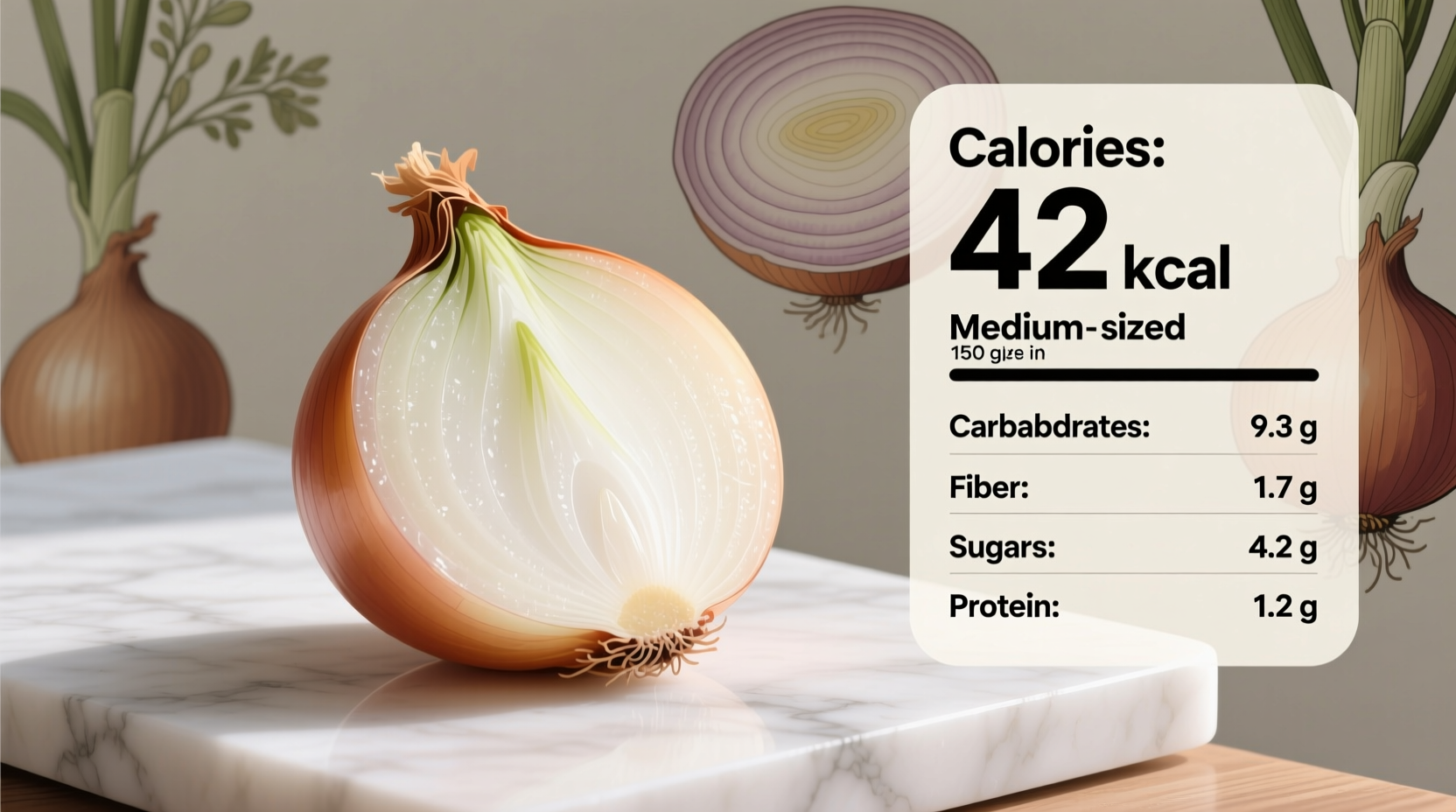Understanding the exact calorie content of common ingredients like onions is essential for meal planning, dietary tracking, and maintaining a balanced diet. Whether you're counting calories for weight management or simply curious about your food's nutritional profile, having accurate information matters.
Breaking Down Onion Calories by Type and Size
Not all onions are created equal when it comes to calorie content. The specific variety, size, and preparation method all affect the final count. Let's examine the nutritional differences across common onion types.
| Onion Type | Standard Serving Size | Calories | Carbohydrates (g) | Fiber (g) |
|---|---|---|---|---|
| Yellow Onion (medium) | 110g | 44 | 10.3 | 1.9 |
| Red Onion (medium) | 110g | 42 | 9.9 | 1.8 |
| White Onion (medium) | 110g | 43 | 10.1 | 1.9 |
| Green Onions (scallions) | 100g | 32 | 7.3 | 2.6 |
| Shallot | 100g | 72 | 16.8 | 3.2 |
This nutritional comparison, sourced from the USDA FoodData Central, shows that while yellow, red, and white onions have nearly identical calorie counts, shallots contain significantly more calories per 100 grams. Green onions (scallions) are the lowest in calories among common onion varieties.
Understanding Onion Nutrition Beyond Calories
While calorie count is important for many people tracking their food intake, onions offer valuable nutritional benefits that extend far beyond their modest energy content:
- Vitamin C: One medium onion provides about 11% of your daily recommended intake
- B vitamins: Particularly B6 and folate, essential for energy metabolism
- Antioxidants: Onions contain quercetin, a powerful flavonoid with anti-inflammatory properties
- Fiber: Approximately 1.9 grams per medium onion, supporting digestive health
- Minerals: Contains small amounts of potassium, manganese, and calcium

Practical Applications: Using Onion Calories in Meal Planning
Knowing the exact calorie content of onions helps you make informed decisions in your kitchen. Here's how to apply this information practically:
For Weight Management
Onions are an excellent addition to calorie-conscious meals. Their strong flavor means you can use less oil or high-calorie seasonings while still creating delicious dishes. A medium onion adds only 44 calories to your recipe while significantly enhancing flavor.
For Blood Sugar Management
With a glycemic load of just 2 for a medium onion, they're suitable for most blood sugar management plans. The fiber content (1.9g per medium onion) helps slow glucose absorption.
Context Boundaries: When Onion Calories Might Vary
Certain preparation methods can significantly alter the calorie content of onions:
- Fried onions: A 1/4 cup of crispy fried onions contains approximately 90 calories due to oil absorption
- Caramelized onions: The natural sugars concentrate during cooking, increasing calories per volume (about 70 calories per 1/2 cup)
- Onion rings: A typical serving (85g) can contain 250-300 calories depending on batter and frying method
These variations demonstrate why understanding preparation methods is crucial when tracking calories accurately. The raw onion values provided earlier apply specifically to uncooked onions.
Common Misconceptions About Onion Calories
Several myths persist about onion nutrition that deserve clarification:
- "Onions are high in sugar": While onions do contain natural sugars (about 4.7g per medium onion), this is comparable to many non-starchy vegetables and comes with fiber that moderates blood sugar impact
- "Cooking removes all nutritional value": While some heat-sensitive nutrients decrease, cooking actually increases the bioavailability of certain antioxidants like quercetin
- "All onion varieties have identical nutrition": As shown in our comparison table, shallots contain nearly twice the calories of other common onion types per 100g
How Onions Fit Into a Balanced Diet
With their low calorie count and rich nutrient profile, onions are a valuable component of most dietary patterns. Whether you're following Mediterranean, DASH, or plant-based eating approaches, onions provide flavor without excessive calories.
Professional chefs often use the "sofrito" technique—sautéing onions, garlic, and other aromatics as a flavor base—which maximizes taste while keeping overall calorie counts in check. This professional approach demonstrates how understanding ingredient nutrition helps create satisfying meals within calorie goals.











 浙公网安备
33010002000092号
浙公网安备
33010002000092号 浙B2-20120091-4
浙B2-20120091-4